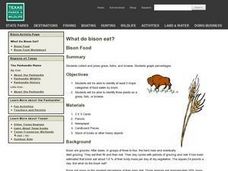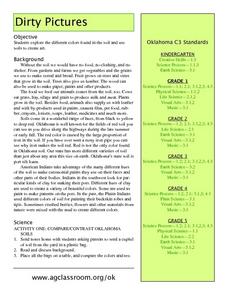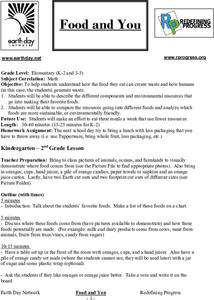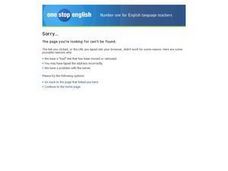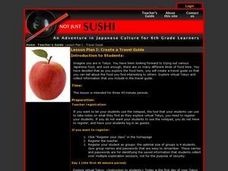Curated OER
What do Bison Eat?
Students identify the three major categories of food eaten by bison. In groups, they collect examples of grass and forbs and press them. They complete a chart of the percentages of each type of food the bison eat in a day. They...
Curated OER
Food For Art-Creating Art With Food Such As Dried Seeds and Pastas
Students brainstorm the many uses of food rather than eating it. Using the internet, they research museums to find pieces of art made out of food. They plan, design and create a dried food centerpiece and present their creation to the...
Curated OER
Native Americans
Students, in groups, research various Native American tribes. They wirte a report about the tribe which includes information about their food and ceremonies, among other things. They create a diorama and a poster that shows how they...
Curated OER
Exploring the Food and Dining Patterns of Cameroon: Classification Activity
Students practice using new vocabulary on the dining practices of Cameroon. Using classification techniques, they put words into different categories. As a class, they review and discuss the answers.
Curated OER
Dirty Pictures
Students investigate how food, clothing and shelter come from soil after they examine soil from their own backyards. They map soils on the color wheel before making glue and soil pictures and tie-dying T-shirts in red soil.
Curated OER
Sustainable Dining
Students identify consumer products and sustainable foods. They calculate the differences in prices and applying those prices to the cost of a meal. They also discuss the costs and benefits of buying sustainable products.
Curated OER
Food and You
Students examine the types of foods they eat. They describe the different components and resources that go into making their favorite foods. They also compare the resources going into different foods and identify ones which are more...
Curated OER
"Mush Lab"
Students use the information they learned from reading food labels to create mush meals. They blend unlikely meals together to form the mush and then evaluate its nutritional value. They examine their own eating habits after the lab is...
Curated OER
From Seed to Bread
Learners examine how some of their food comes from plants by baking bread. They listen to teacher read alouds that set the stage for the activity.
Curated OER
Pies: A Practical Application
Students participate in making a pie. They are to discuss the nutritional value and the different types of pies. They also answer questions from the teacher about fat and they complete a pie evaluation form.
Curated OER
What's For Lunch? (Digestive System)
Students identify components of the digestive system and explain functions. They create and label a diagram of the digestive system. They watch the video "Passage of Food" and perform a proper dissection of a frog. They create a flow map...
Curated OER
In Search of Good British Food
Students use the Internet to research the culture of British food. They determine the most common foods found in a full English breakfast, and whether they think the foods are tasty or not.
Curated OER
Exploring Habitats
Students analyze the difference between the human habitat and the different habitats of animals in the six lessons of this unit. The students' imaginations and literature are used to explore important aspects of the living environments...
Curated OER
King Henry's Meat Group
Second graders hear a story about King Henry the Egg, Little D and the meat group. They act out the parts as the story is read aloud and complete a worksheet. They pantomime activities that use and build muscle
Curated OER
We Need All Five!
Second graders review foods and their groups. They discuss the reasons why they need to eat from all five food groups. They try to write using only a few of their five fingers to see what happens when you don't use all five fingers.
Curated OER
Arianna Travels the Orient Express
Fourth graders discuss how they eat when they travel. They resequence a letter that has been separated into pieces. They read the letter aloud, discuss the foods eaten by the writer and analyze whether she ate the right amount of food...
Curated OER
Food Model Mobiles
Students create mobiles that represent a day's intake or other criterion, such as healthy snacks, Milk Group foods, breakfast foods, etc.
Curated OER
Get a Feel for Food
Students describe the size, shape and feel of a food hidden in a "feely bag" and then select the Food Model from a group that corresponds to the food. In a tasting party afterwards, they sample the food and describe the color, taste and...
Curated OER
Not Just Sushi: Create a Travel Guide
Sixth graders create a travel guide as they explore a virtual tour of Tokyo. They take notes on the food that can be found in Tokyo and include the collection information in their travel guide.
Curated OER
Environmental Mathematics
Eighth graders determine food that they would need to survive in the wild. They graph the best foods for their environments and rate the survivability rate for each member of their group.
Curated OER
The shop is important
Young scholars consider where food comes from and how it gets to them. They identify where shops are found and visit one to investigate how it operates.
Curated OER
Oh Nuts! - Calories Count
Learners measure and record the mass of the nut to be tested to the nearest 0.01 gram.
Curated OER
Our Food and Microorganisms
Students answer questions about how microorganisms can affect our food supply and how they can be controlled. The first set of inquiry activities are directed by the teacher. Subsequent activities are based on students generating their...


